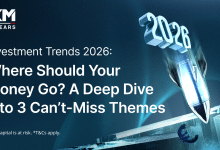The 5 common types of markets to start trading

Just getting started on trading? You’re probably wondering about the types of markets available and which one you should trade. This decision can be daunting for beginners since each market offers unique opportunities with varying risk levels and potential returns. Therefore, it’s important to research and understand the basics of each market before deciding where to invest your funds. So, to help you out, here are the most common types of markets to start trading.
Common types of markets to start trading
1. Shares CFD
Shares CFD trading involves leveraging your investment to gain full exposure to shares with a small deposit. This means that even with a modest deposit, you can gain full exposure to the market movements of various shares. However, it’s important to remember that while leverage can amplify potential profits, it also significantly increases the risk of losses.
One key advantage of share CFD is that it lets you speculate on both rising and falling markets. This means that you can capitalise on price movements in either direction. Additionally, CFDs offer the convenience of buying and selling shares without needing to own the actual underlying asset. It’s a convenient way to diversify your portfolio and capitalise on market movements.
Different online platforms offer CFDs with varying benefits. For instance, the IG trading platform provides full exposure with competitive margins, low commissions on US and Hong Kong shares, access to more than 17,000 markets worldwide, and exclusive out-of-hours trading on over 90 US stocks. With out-of-hours trading, you can trade when others can’t.
2. Forex
Also known as FX trading or foreign exchange trading, Forex trading involves converting one currency into another. In essence, you speculate on the fluctuation of exchange rates by purchasing one currency and selling another at the same time.
The Forex market is highly active and ranks among the world’s most traded markets, with individuals, companies, and banks collectively conducting approximately $6.6 trillion in Forex transactions daily. Although traditionally dominated by major global banks and institutions, foreign exchange trading has gained popularity among individual investors in recent years. One of the main drivers behind its popularity is easier access, thanks to online brokers like IG Group.
Currencies are always traded in pairs. There’s a wide array of combinations to pick from, but only a few are highly liquid. Some of the most active pairs are the euro versus the US dollar (EUR USD), the US dollar versus the Japanese yen (USD JPY), and the British pound versus the US dollar (GBP USD).
Forex is popular among traders seeking lucrative short and medium-term opportunities. The appeal of forex lies in its accessibility 24 hours a day, five days a week – a flexibility unmatched by traditional markets like stocks or indices.
3. Indices
Indices serve as indicators of the overall performance of a group of shares listed on an exchange. These indices are commonly traded using financial derivatives such as Contracts for Difference (CFDs) due to the absence of physical assets underlying them.
Trading indices involves investing in a basket of stocks or sectors through a single trade. These indices are typically made up of the largest and most actively traded companies within a specific sector or region. Therefore, it provides diversification and exposure to multiple companies. For example, if you trade the S&P 500 index, you’d be exposed to 500 of the largest publicly traded companies in the US.
This strategy can be particularly beneficial during times of volatility when individual stock performances may vary significantly. During the Covid-19 pandemic, for instance, most sectors experienced significant declines due to lockdown before gradually recovering. Notably, tech stocks demonstrated resilience throughout this period. If you took a long position on the NASDAQ 100 Tech Index (US Tech 100), which consists of the largest US tech companies, during that period, you likely would have seen profitable returns amid the market’s recovery.
4. Commodities
Commodities are raw materials or goods, such as sugar, oil, and precious metals like gold. These materials are vital for producing food, energy, and clothing, making them the backbone of our economy. Trading commodities means the act of buying and selling these materials. Just like stocks, commodities are bought and sold on exchanges. Some popular exchanges where commodities are traded include the Chicago Mercantile Exchange (CME), New York Mercantile Exchange (NYMEX), and London Metal Exchange (LME).
Commodities traders engage in speculation by making bets on the future price movements of commodities. This involves buying futures contracts (going long) if they anticipate a price increase or selling futures contracts (going short) if they predict a price decrease.
One reason why investors look to commodities for diversification is because they have a low correlation with traditional securities like stocks and bonds. When stock prices go down, commodity prices might go up, and vice versa. This can help investors protect their money during times when the stock market is unpredictable.
5. Cryptocurrencies
Cryptocurrency refers to a type of digital or virtual currency that employs cryptographic technology to ensure the security of transactions. Unlike traditional currencies, cryptocurrencies do not have a centralised authority overseeing their issuance or regulation. Instead, they rely on decentralised systems to validate transactions and create new units of currency.
Cryptocurrency trading involves making financial decisions based on the price movements of individual cryptocurrencies relative to the dollar or other cryptocurrencies. You can choose to either trade crypto against the dollar in crypto-to-dollar pairs or trade one cryptocurrency against another in crypto-to-crypto pairs.
Among the most popular methods of engaging in cryptocurrency trading is through CFD, which offers increased flexibility, leverage opportunities, and the ability to take both long and short positions. However, you can also trade cryptocurrency directly by buying and selling the digital coins on an exchange platform. When you opt for this method, you are acquiring the actual cryptocurrencies themselves instead of a contract.
So, which market should you trade?
There are various factors that you need to consider when choosing a market to trade in. These factors include trading style, financial resources, location, and preferred time of day for trading.
If you’re still unsure, make sure you do your research and analyse each market carefully. IG’s website offers valuable resources to help you make informed decisions. Plus, with access to more than 17,000 markets, IG provides numerous opportunities for traders seeking diversity.
For detailed information on the available trading markets and how they align with your preferences, visit IG’s website.
Sponsored by IG. CFDs are complex, high risk and losses can be substantial. 70% of retail client accounts lose money when trading CFDs with this investment provider.
Latest Thailand News
Follow The Thaiger on Google News:


























